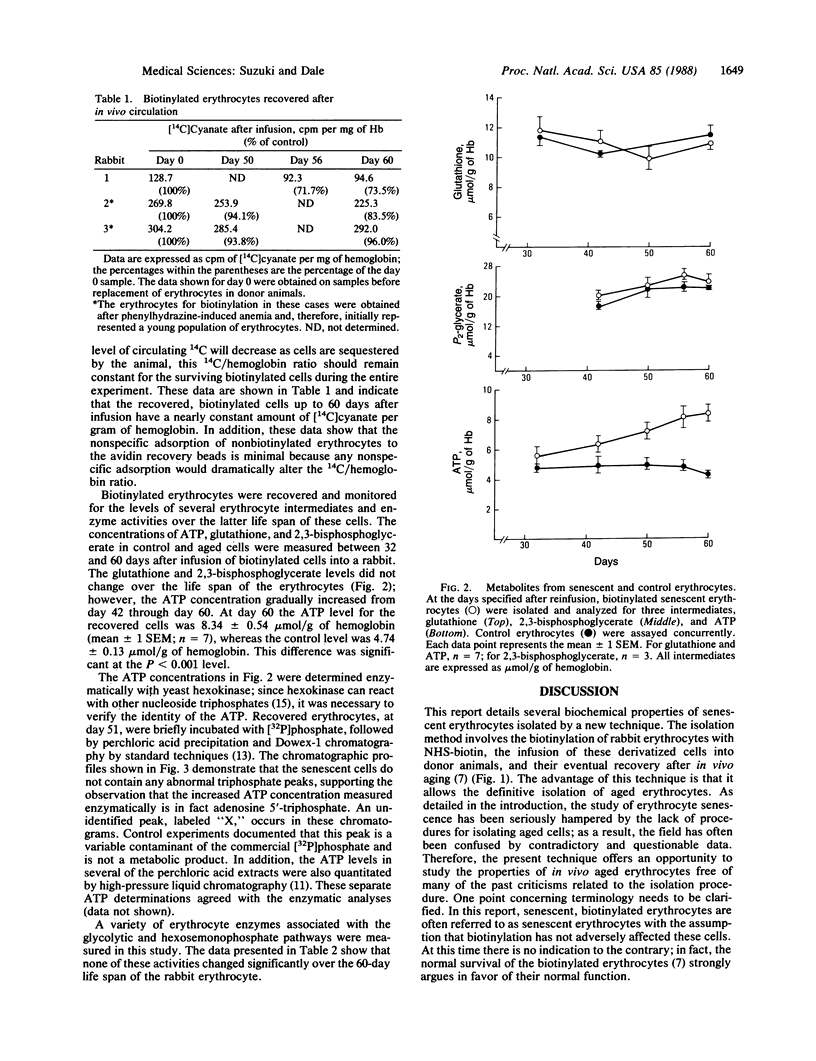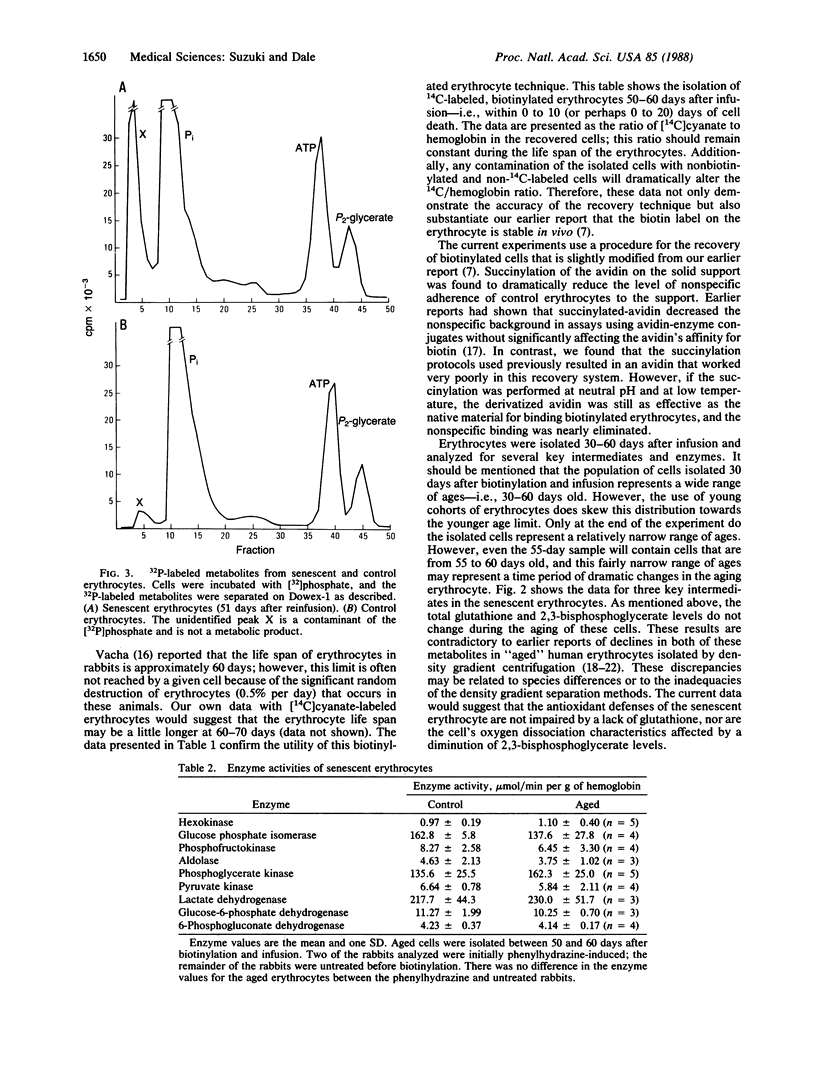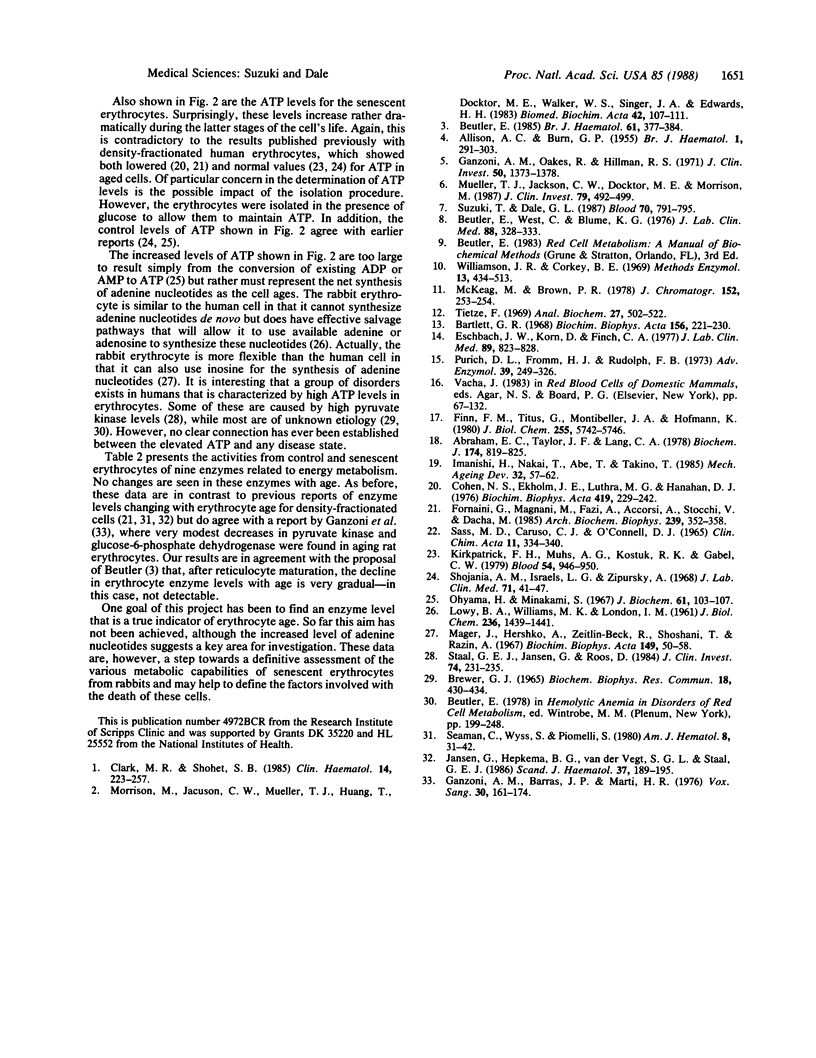Abstract
Rabbit erythrocytes were covalently labeled with biotin and then infused into the donor animal. Up to 60 days after infusion, the biotinylated cells were selectively isolated by their affinity for avidin. These aged erythrocytes, which are within 10 days of death, were analyzed for several biochemical parameters. The 2,3-bisphosphoglycerate and glutathione levels of these cells were constant with age; however, the adenosine 5'-triphosphate concentrations increased approximately 75% as the cells approached the end of their life span. The activities of several glycolytic enzymes did not change with age.
Full text
PDF




Selected References
These references are in PubMed. This may not be the complete list of references from this article.
- ALLISON A. C., BURN G. P. Enzyme activity as a function of age in the human erythrocyte. Br J Haematol. 1955 Jul;1(3):291–303. doi: 10.1111/j.1365-2141.1955.tb05511.x. [DOI] [PubMed] [Google Scholar]
- Abraham E. C., Taylor J. F., Lang C. A. Influence of mouse age and erythrocyte age on glutathione metabolism. Biochem J. 1978 Sep 15;174(3):819–825. doi: 10.1042/bj1740819. [DOI] [PMC free article] [PubMed] [Google Scholar]
- BREWER G. J. A NEW INHERITED ABNORMALITY OF HUMAN ERYTHROCYTES: ELEVATED ERYTHROCYTIC ADENOSINE TRIPHOSPHATE. Biochem Biophys Res Commun. 1965 Feb 3;18:430–434. doi: 10.1016/0006-291x(65)90726-6. [DOI] [PubMed] [Google Scholar]
- Bartlett G. R. Phosphorus compounds in the human erythrocyte. Biochim Biophys Acta. 1968 Mar 11;156(2):221–230. doi: 10.1016/0304-4165(68)90251-1. [DOI] [PubMed] [Google Scholar]
- Beutler E. How do red cell enzymes age? A new perspective. Br J Haematol. 1985 Nov;61(3):377–384. doi: 10.1111/j.1365-2141.1985.tb02841.x. [DOI] [PubMed] [Google Scholar]
- Beutler E., West C., Blume K. G. The removal of leukocytes and platelets from whole blood. J Lab Clin Med. 1976 Aug;88(2):328–333. [PubMed] [Google Scholar]
- Borchardt R. T., Hegazi M. F., Schowen R. L. Determination of O-methylated metabolites of cathecholamines using high-performance liquid chromatography and electrochemical detection. J Chromatogr. 1978 May 11;152(1):253–259. doi: 10.1016/s0021-9673(00)85363-7. [DOI] [PubMed] [Google Scholar]
- Clark M. R., Shohet S. B. Red cell senescence. Clin Haematol. 1985 Feb;14(1):223–257. [PubMed] [Google Scholar]
- Cohen N. S., Ekholm J. E., Luthra M. G., Hanahan D. J. Biochemical characterization of density-separated human erythrocytes. Biochim Biophys Acta. 1976 Jan 21;419(2):229–242. doi: 10.1016/0005-2736(76)90349-7. [DOI] [PubMed] [Google Scholar]
- Eschbach J. W., Korn D., Finch C. A. 14C cyanate as a tag for red cell survival in normal and uremic man. J Lab Clin Med. 1977 Apr;89(4):823–828. [PubMed] [Google Scholar]
- Finn F. M., Titus G., Montibeller J. A., Hofmann K. Hormone-receptor studies with avidin and biotinylinsulin-avidin complexes. J Biol Chem. 1980 Jun 25;255(12):5742–5746. [PubMed] [Google Scholar]
- Fornaini G., Magnani M., Fazi A., Accorsi A., Stocchi V., Dachà M. Regulatory properties of human erythrocyte hexokinase during cell ageing. Arch Biochem Biophys. 1985 Jun;239(2):352–358. doi: 10.1016/0003-9861(85)90698-8. [DOI] [PubMed] [Google Scholar]
- Ganzoni A. M., Barras J. P., Marti H. R. Editorial: Red cell ageing and death. Vox Sang. 1976;30(3):161–174. doi: 10.1111/j.1423-0410.1976.tb02809.x. [DOI] [PubMed] [Google Scholar]
- Ganzoni A. M., Oakes R., Hillman R. S. Red cell aging in vivo. J Clin Invest. 1971 Jul;50(7):1373–1378. doi: 10.1172/JCI106619. [DOI] [PMC free article] [PubMed] [Google Scholar]
- Imanishi H., Nakai T., Abe T., Takino T. Glutathione metabolism in red cell aging. Mech Ageing Dev. 1985 Oct 14;32(1):57–62. doi: 10.1016/0047-6374(85)90035-1. [DOI] [PubMed] [Google Scholar]
- Jansen G., Hepkema B. G., van der Vegt S. G., Staal G. E. Glycolytic activity in human red cell populations separated by a combination of density and counterflow centrifugation. Evidence for an improved separation of red cells according to age. Scand J Haematol. 1986 Sep;37(3):189–195. doi: 10.1111/j.1600-0609.1986.tb02296.x. [DOI] [PubMed] [Google Scholar]
- Kirkpatrick F. H., Muhs A. G., Kostuk R. K., Gabel C. W. Dense (aged) circulating red cells contain normal concentrations of adenosine triphosphate (ATP). Blood. 1979 Oct;54(4):946–950. [PubMed] [Google Scholar]
- LOWY B. A., WILLIAMS M. K., LONDON I. M. The utilization of purines and their ribosyl derivatives for the formation of adenosine triphosphate and guanosine triphosphate in the mature rabbit erythrocyte. J Biol Chem. 1961 May;236:1439–1441. [PubMed] [Google Scholar]
- Mager J., Hershko A., Zeitlin-Beck R., Shoshani T., Razin A. Turnover of purine nucleotides in rabbit erythrocytes. I. Studies in vivo. Biochim Biophys Acta. 1967 Nov 21;149(1):50–58. doi: 10.1016/0005-2787(67)90690-9. [DOI] [PubMed] [Google Scholar]
- Mueller T. J., Jackson C. W., Dockter M. E., Morrison M. Membrane skeletal alterations during in vivo mouse red cell aging. Increase in the band 4.1a:4.1b ratio. J Clin Invest. 1987 Feb;79(2):492–499. doi: 10.1172/JCI112839. [DOI] [PMC free article] [PubMed] [Google Scholar]
- Oyama H., Minakami S. Studies on erythrocyte glycolysis. V. Change of the glycolytic intermediate pattern of reticulocytes during maturation. J Biochem. 1967 Jan;61(1):103–107. doi: 10.1093/oxfordjournals.jbchem.a128509. [DOI] [PubMed] [Google Scholar]
- Purich D. L., Fromm H. J., Rudolph F. B. The hexokinases: kinetic, physical, and regulatory properties. Adv Enzymol Relat Areas Mol Biol. 1973;39:249–326. doi: 10.1002/9780470122846.ch4. [DOI] [PubMed] [Google Scholar]
- SASS M. D., CARUSO C. J., O'CONNELL D. J. DECREASED GLUTATHIONE IN AGING RED CELLS. Clin Chim Acta. 1965 Apr;11:334–340. doi: 10.1016/0009-8981(65)90223-8. [DOI] [PubMed] [Google Scholar]
- Seaman C., Wyss S., Piomelli S. The decline in energetic metabolism with aging of the erythrocyte and its relationship to cell death. Am J Hematol. 1980;8(1):31–42. doi: 10.1002/ajh.2830080105. [DOI] [PubMed] [Google Scholar]
- Shojania A. M., Israels L. G., Zipursky A. The relationship of adenosine triphosphate concentration to erythrocyte aging. J Lab Clin Med. 1968 Jan;71(1):41–47. [PubMed] [Google Scholar]
- Staal G. E., Jansen G., Roos D. Pyruvate kinase and the "high ATP syndrome". J Clin Invest. 1984 Jul;74(1):231–235. doi: 10.1172/JCI111406. [DOI] [PMC free article] [PubMed] [Google Scholar]
- Suzuki T., Dale G. L. Biotinylated erythrocytes: in vivo survival and in vitro recovery. Blood. 1987 Sep;70(3):791–795. [PubMed] [Google Scholar]
- Tietze F. Enzymic method for quantitative determination of nanogram amounts of total and oxidized glutathione: applications to mammalian blood and other tissues. Anal Biochem. 1969 Mar;27(3):502–522. doi: 10.1016/0003-2697(69)90064-5. [DOI] [PubMed] [Google Scholar]


